 L.M.'s Top Ten art stuff of 2005 (from my shadow Office of the Governor General in my shadow government, in a tiny perfect universe) L.M.'s Top Ten art stuff of 2005 (from my shadow Office of the Governor General in my shadow government, in a tiny perfect universe)
The list and images are in the comments.
Ok Here we go: (in no particular order)
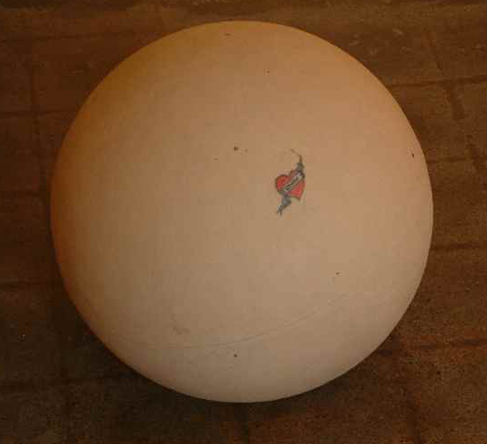
Edith Dakovic's "Mother Ball" from Future Species: Hybrids at the Mocca, Toronto. A latex ball of 'skin' with hairy moles, warts and a tattoo.
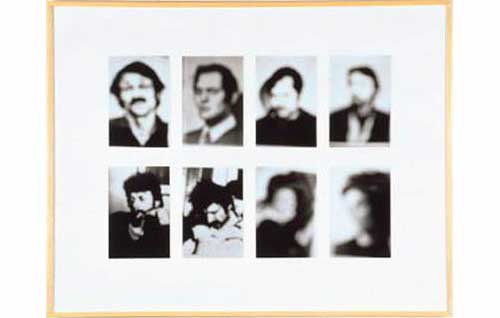
"Regarding Terror: The RAF-Exhibition" Kunst-Werke, Berlin .
I have an unhealthy fascination with the Baader-Meinhof group, (hate-hate-hate Andreas Baader, sympathetic to Gudrun Ensslin. But really! Ulrike Meinhof! Trying to smuggle your children to a Palestinian orphanage? Aside from the obvious disadvantages for your daughters in that setting, Palestinian orphans have enough fucking problems of their own without having to share their cots with the spawn of some guilty German Lefty) so I got my history jollies with this huge group show. Of course Gerhard Richter's images (above) of Red Army Faction members left all the other art work in the dust.
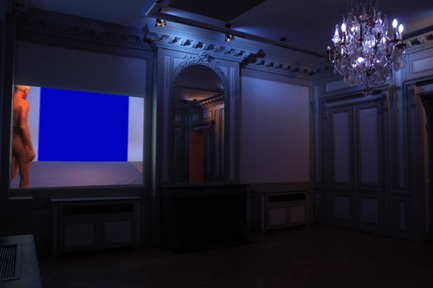
Johannes Zits' stellar blue room installation, "In and Out" from the Canadian Club exhibition at the Canadian Cultural Centre in Paris.

John Dickson's "Burning City" from Canadian Club at the Canadian Cultural Centre in Paris. (little cardboard buildings and a fog machine)
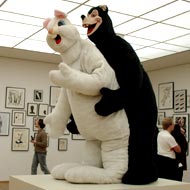
The Flick Collection at the Hamburger Bahnhof in Berlin. An insane amount of real estate filled with one smart shopper's contemporary art goodies (Nazi loot still has buying power). I went there with a Berlin artist pal and we heckled and giggled our way through only half the show after 4 hours. It was time to leave when I stumbled out of the tippy-floored Paul McCarthy cowboy wanker saloon, and a security guard decided I was his new best friend and proceeded to direct me to all the other art about fucking. (didn't see Istvan Kantor's blood on the wall, those tidy Germans must have quickly washed it off )

Lisa Neighbour's entrance piece at Rodman Hall, St. Catherines. (reflected into infinity between two big antique mirrors)
Cedric Caspesyan's art writing on his Artquebus blog as well as his thoughtful and generous responses to simpleposie's questions. (thank goodness, because she never gets anything thoughtful or generous out of me)
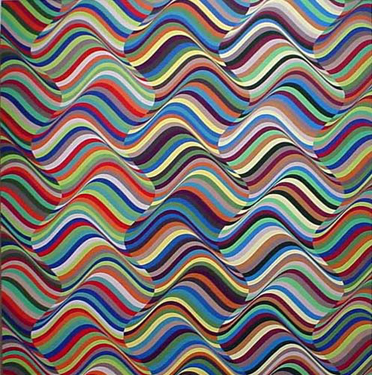
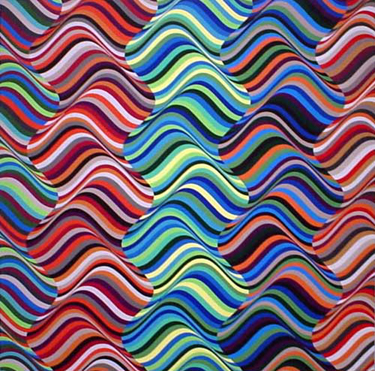
Angela Leach! Angela Leach! "Abstract Repeat Wave #61" & "Abstract Repeat Wave #62"

Fastwürms "Blood Clock" installation at TAAFI, Toronto. (actually, their cat photos were in Paul Petro's room, I don't have an image of their installation, but I did purchase all the cat postcards available, and I don't know why, I just wanted them.)
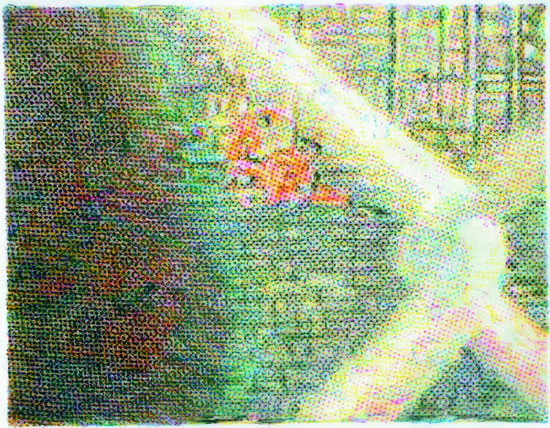
Stephen Andrews' oil & wax paintings,"POV" at Paul Petro (was waiting for permission to post his image, but as Outlaw Neon once said, it's easier to apologize than to get permission) Like his previous projects, JPEG and Fax, I end up always feeling humbled as an artist.
I share some of these picks. Especially the Fastwurms cat postcards. We pull them out and gaze at them when we are feeling glum.
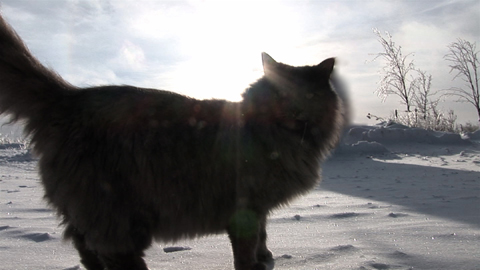
Here's another Fastwürms cat for you.
is that the great white north?
The Great White Creemore.
Growing up in Germany during those heady RAF, Baader-Meinhof Gang days,
I am left with an odd sense of nostalgia. Must be the Richter und Henker.
Awesome list.
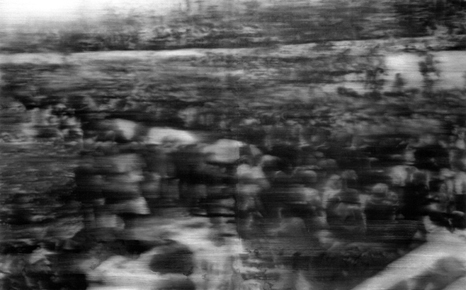
"Funeral" - Gerhard Richter
Then, Tino, you would have really enjoyed the RAF show. They used the whole first floor of the museum for a historical presentation, year by year with magazine covers, newspaper articles, archival news footage etc. "Heady" is an apt description for their media presence, glamorous in the fullest definition of the word. Unfortunately on the next 4 floors of the exhibition, too many younger artists simply dealt with trite observations about the RAF's outlaw stardom. (curators should have edited that aspect down a bit, we got that point) Richter was the oldest artist in the bunch, yet his work held the most poignancy and depth in that it was meant to recede into the past the moment it was made.
That's the same reason I respond so strongly to Stephen Andrew's paintings from news service photos of the current war in Iraq.
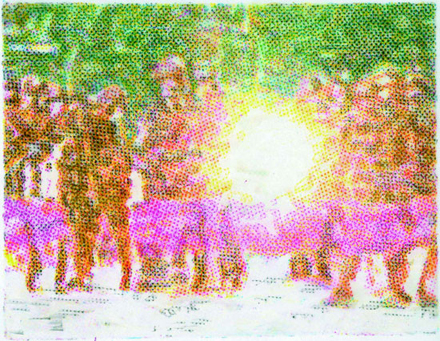
"Pink Barricade" - Stephen Andrews
The black cat image above is their New Years greeting. (Bunny, the bitch killing machine, in an ice storm)
And finally, here are the "Blood Clock" installation images from Fastwürms at TAAFI.
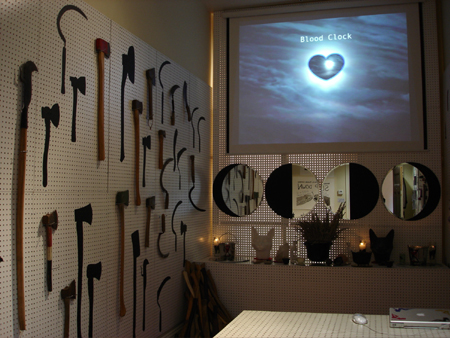
(I bought a print of an owl killing that mouse in the foreground.)
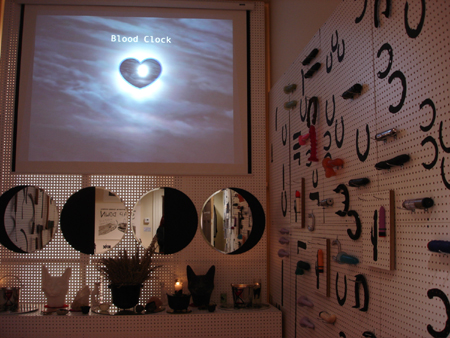
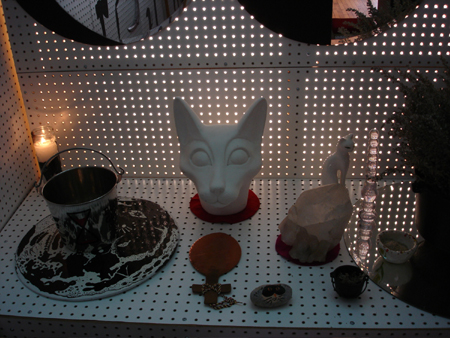
L.M., Tino, everyone....do you know Harun Farocki's work? He was on my top ten for 2003: Harun Farocki's lecture Bombs Which Take Pictures, presented by the (CMCE) at OISE/UT, and Images Festival in Toronto (many many thanks to Lana Lin for turning me onto Farocki)
He's Mr. Military Technology. I love how he has this hybrid practice of artist and Gwyne Dyer-esque war nerd. I've been trying to catch up on my art theory lately and reading a bit more about relational aesthetics (thanks SR) and getting irritated by the general lack of interest in content. I'm always irritated by that. Art can be lots of things that aren't art, but why bother with any of it unless there's some matter you are chewing on? Farocki 's work may be relational in that the practice takes the form of political lectures and documentary style films, but it's all about imparting genuine (fascinating) information. Like, did you know that at one time bombs were actually phsyically guided from the airplane with long wires?
I missed "Images of the World and the Inscription of War", I'll check out Suspect video to see if they have it. (Also looking for the movie "Stammheim".)
Now I'm insanely curious about the wires. Did they go all the way to the ground? That's a long wire. (and this wire revelation is so off the wall that it's impossible to ask a stupid question about it)
Is he (Farocki) an artist, though? That page says "documentary filmmaker," which includes a certain built-in didacticism. To return to an old perennial argument we've had, please allow me to register a complaint about your use of the word content. The best art always has content, which might be irrational, anti-narrative, anti-didactic, and generally fucked up. I'm opposed to art that teaches, as its main purpose. There are better vehicles for that--such as documentary film and video. Maybe the issue is, to impart information as you're describing, requires a bond of trust between the viewer and the artist, such as you would have with a teacher or a writer of genre fiction. We should trust politicians, but I don't think we need to trust artists in that same way. A big part of the fun of art consumption is figuring out whether you're having your chain pulled, as the cliche goes. You might actually learn something, but only because you studied up on it post the art experience.
Not sure where any of this fits in with relational aesthetics, which sounds bad on its face.
No one here ever cares if comments fit in snugly into each other.
So let me say something about tanks:
I killed all my time on January 1st watching Tank Day on the History Channel. I didn't know about the flame throwing tanks. They pulled trailers of petroleum jelly that were combusted (new word, all mine) and shot out from special guns on the sides of the vehicles. The archival footage of this burning jelly being sprayed on buildings and people is so horrifying that I have a whole new sub-section of tank nightmares to sleep with. (most of the WW2 crews hated this weaponry - on both sides of the conflict - and would commit suicide if they were close to being captured)
Sally and I attended the Farocki talk in Toronto a couple of years ago.
Amazing. Yes, L.M. I would have been fascinated by the Richter exhibit.
Almost needless to say Chris Marker's 'A grin without a cat' shares a similar
theme I think. The defeated forces of the left or extreme left and their impact
on society as a whole in Europe ... oh, all this requires so much wine.
Farocki, artist?, check!
Chris Marker is one of those people I know I should look at and keep not looking at. Sounds really great. And yep Farocki is an artist—he had an installation at the Art Gallery of Ontario (among other prestigious venues around the world) to prove it. But definitely a hybrid, like I said above. ... I knew I was collapsing too many trains of thought into that one hurried post. And unfortunately I can't unpack it all tonight. But when I say content, I don't mean necessarily political or didactic messages. For instance, this image by Erika Somogyi, recently posted on Tom's blog is super content-ful, and I really love it. There is a big wave of interest in art being something other than art, and I'm very intrigued and challenged by that idea. But I'm gleaning that there are a couple of ways this goes. One is that art approaches fashion, design, and dissolves into the products of mass media. This is kind of undeniable but also kind of obvious and kind of boring. Another is art dissolving into sets of relationships, social interactions. Rirkrit Tirvanija and Liam Gillick being prime examples. And also the past few years of Instant Coffee activity here in Toronto. This is a bit more interesting to me, but I'm not sure I like it. For instance, I have lots of reasons for social interaction (activism occasionally being one of them, getting shit-faced being another, family obligations, emotional ties to friends, entertainment, etc.) that don't require art to help them along. It all seems a bit forced and as socializing goes, super awkward. "okay, we're all at an art opening, but it's not really an art opening, it's a party! The art is the party, get it? A really fun party! Are you having fun yet? Are you being social enough? no? Then you are not a good relational aesthetician and you also a party-pooper." Blegh. These examples seem to me to be more about playing out social dynamics, marketing, and economics than about content. But you can dissolve art boundaries, and still have content! And one model is Farocki. There's lots of others such as *********** and **********. I'm gonna go away for a couple days now and think about them.
CAVEAT: I just woke up thinking that this above is pretty unfair to Instant Coffee. I must also say that I really do respect them and their project. They did a lot to energize art in this town (like Free Parking Gallery before them). And I think it may be a sort of old-fashioned reluctance to let go of traditional art structures, on my part, that makes me stuffy about it. Also I'm a born hermit but I think the art as party worked for many many people. Instant Coffee's listing is simply essential, and now completely taken for granted. And much to their credit, I don't see them claiming the service as an art project, which they could if they wanted to be irritating.
Now I can't stop thinking about Instant Coffee. They really became an ubiquitous curatorial force, which is no small feat here in Clique-ville. And their presence remains, despite the fact that two principal founding members are off in Vancouver. They function/functioned like a sort of art engine, spinning off all kinds of activity, some more engaging, some less. I'm wondering what's written about them that's academic/critical/theoretical . Ex-Instant Coffee member Timothy Comeau has certainly been talking in the territory. Who else? Anybody know?
I was moving files to my new system and found a bunch of links to articles about the Flick collection that I had sent to some friends several months ago and the controversy surrounding Flick's Nazi grandpa, so I thought I'd just post them in this thread.
This one is especially interesting as it touches on the old "pure art" argument. (Leni Riefenstahl spoiled it for all the pure artists and Germany isn't ready to touch her with a ten foot pole)
Gerhard Richter is quoted in this one. (have I mentioned lately that I love him?)
This is a bit redundant to the articles above, but I think it also relates to history is still current events. I also see the relationship to the RAF's fury over many leaders of postwar Germany being the same old Nazis. I stumbled into Berlin at a great time to see these shows, and got charged up in spite of the weather.
(France is so fucking different, no goddam imperialist historical guilt there, "why wouldn't the world not want to be French", they thought. "We were Nazi victims too!", "And finally in 1996 we wondered what happened to all our Jews. Oh ya, now we remember, had them all lined up for them, didn't we now? Slipped our minds somehow.", "Don't forget to visit the Louvre and check out our Napoleonic plunder!")
a short manifesto from some Berlin protesters.
Thank you. LM, and thinking of Berlin, may I recommend the epic graphic novel
Berlin by Jason Lutes. He's half way so far.
"There is a big wave of interest in art being something other than art..."
I think that started in the '60s and crapped out about 1991. Possibly it peaked with Catherine David's Documenta X.
Again, I strongly disagree that content means social content, or that "social content" in the art context has much interest. Art is art and agitprop is agitprop. Sometimes they spill over, but combining them is too vague (and "averagely earnest") as a goal. Rirkrit Tiravanija is just warmed over Situationism or '70s Conceptualism a la Food or the 112 Greene Street co-op, and came along when the NY art world was having a guilty moment after the collapse of the '80s market pig-out. Within moments he was selling editions of empty noodle cups you could buy for a pretty penny, fill up, and "make your own art."
I think we agree, at least, that Kristin Lucas' work is good and broke some interesting ground in the late '90s on the hybrid video/performance/cyborg/psychological-effects-of-technology front. It doesn't "dissolve into media" and it doesn't "dissolve into social relationships." Even her most recent work, which is more about getting out there in the open air, doesn't dissolve into anything.
More resolving, less dissolving!
Well. I'd really like to disagree with you but we are not communicating effectively enough for me to even get started properly. When you say you strongly disagree that content means social content I hope your issue is with Bourriaud and not with me. Cause I didn't say that. In fact, I keep trying to explicitly say the opposite, but I guess I'm not getting through.
That said, I'd venture that I am more interested in art dissolving than you are. And yeah it's old hat, but the internet has re-opened the challenge. Is Paper Rad art? Does it matter one bit if they are or not? I'd say, the question remains open but the answer utterly unimportant. Why? cause they are just doing their thing (ie: content) without meta-level superstructure relational this or that. Farocki too (I think he's an artist, but who cares? It's irrelevant to the appreciation of his work). Kristin Lucas is different. She is pretty much always pushing the tension of the threat of art's dissolution. And she goes really super far without losing it and always delivers a rich and stunning art show. Which is great, and yes as you know she is one of my very favourite aritsts. The stuff you are saying about Tiravanija is the stuff I was saying (or trying to say, apparently failing) about realtional aesthetics. Dunno where that leaves us.
>>>Is Paper Rad art? Does it matter one bit if they are or not?
Sorry to use capitals but YES YES YES YES.
They are products of art school. One of them has been getting an MFA while they've been showing all over the world. Their work is for sale at Foxy Production gallery. The dealers are part of a process of legitimizing them within art circles.
The internet gives them another layer for disseminating their ART and someone out there in the ether might misunderstand it as being outside the art system but that would be a misunderstanding.
If you're not interested in the relational stuff, why talk about it? I'd say "to know the enemy" but I already know who's been wrecking art--tendentious academics who use the weakness of the art world as a platform for theories that shouldn't have left the sociology department.
I realize I risk sounding like the anti-intellectual chump who hangs around my page saying "theory is the ruination of art."
I don't believe that, but I have been pretty repulsed by the floodgates Situationism etc. opened up of non artists pouring into the art world with crappy ideas they couldn't get published otherwise.
I just don't see how strong work by Lucas can be used as proof that that art is threatening to dissolve into something else. It seems to prove the contrary to me.
Now I know what we are arguing about! that's a relief. You say art isn't threatening to dissolve into something else. You might be right, but there are people/theorists, like Bourriaud, who are looking seriously at the possibility. Me, I'm interested in entertaining the thought. I tend to think it's true, and I'm not sure how that makes me feel. Sometimes I like the blurry lines (as with Farocki and also, as a matter of fact, Tirvanija) and sometimes I don't (as with Bourriaud, who is a theorist, not an artist).
Did you mention Bourriaud further up this thread or somewhere else? I can't find the previous reference.
Earlier you said:
For instance, I have lots of reasons for social interaction (activism occasionally being one of them, getting shit-faced being another, family obligations, emotional ties to friends, entertainment, etc.) that don't require art to help them along. It all seems a bit forced and as socializing goes, super awkward. "okay, we're all at an art opening, but it's not really an art opening, it's a party! The art is the party, get it? A really fun party! Are you having fun yet? Are you being social enough? no? Then you are not a good relational aesthetician and you also a party-pooper." Blegh. These examples seem to me to be more about playing out social dynamics, marketing, and economics than about content.
That would seem to be Rirkrit in a nutshell. If this Bourriard dude, in 2006, is holding that up as a model for something, I say that's dated and he should get on back to the academy. You should slam it and move on. So what if some of your peers get their feathers ruffled!
sorry, somehow missed your above post with the the all caps re: Paper Rad. .I think Paper Rad are artists if they call themselves artists, but getting an MFA don't mean nothin. Is David Byrne an artist just cause he went to art school? And Yeah you bet, I'm interested in the relational stuff! It's bugging me a lot...wouldn't bother with all this otherwise. Also my own practice is all up in this territory. Street performances, lecture performances..
Oops, sorry Tom. I'm multi-tasking too much these days and skipping steps in my head. I really thought I'd mentioned Bourriaud here in this thread. But you know even still I don't think it's a good idea to just dismiss this stuff out of hand. Unless you dont' give a hoot for "the discourse", which I know you do, despite your anitpathy toward theorists.
They say about lawyers that you don't go to law school to learn law but "think like a lawyer"--to see more than one side, develop arguments, think your way around problems. I studied art to think like an artist and I've tried to practice it with the values and ways of thinking I acquired. It starts with visual acuity, or curiosity, a way of "looking" at the world, and opens up to a whole range of issues, media, and new problems. You asked, does it matter if Paper Rad didn't emerge from this value system, and I say yes it does. I'm interested in the people doing "advanced" work in my field, secondarily in "primitives," and hardly at all, people who think they're artists because they've mastered some skill set. If studying some extracurricular science or philosophy helps or is of interest, pursue it for sure. But I don't see the various fields of study as that porous, ultimately. Otherwise the investigations and work of Duchamp, say, as Bill and I were discussing earlier, would have led to an institutional structure of "Duchamp schools" totally outside of the art world (market, critics, colleges, museums). As it is, he is understood and subsumed in the art world, not in the terms of some wholly new discipline.
And I'm not against theorists, just bad or irrelevant theory by people with no sensitivity to art issues. I'm even open to relational aesthetics, though it sounds like an unappetizing brand of medicine and if it's "Rirkrit studies" it goes way down my list.
I'm interested in your statement that the fields are not so porous. I tend to agree, but unfortunately, or fortunately, it's art that's the most porous! It's lots easier for an engineer to down tools one day and take up art than vice versa. There is plenty of good info in art school but not everyone who goes is an artist, nor even a critical thinker, and not all artists, even the ones with good critical faculties, went to school. As for the Duchamp conversation with Bill... do you have a link? I've either missed it or forgotten.
We had it on the phone, this is the first written draft!
"It's lots easier for an engineer to [put] down tools one day and take up art than vice versa."
I strongly disagree with the initial proposition for the reasons about art training I mentioned. As for the vice versa, it just strikes me as self-deprecating. To heck with these people who hate art and artists, I'm not admitting any weakness to them. Besides, artists will learn complicated engineering (or other) tasks as needed. They do it all the time. (Kenneth Snelson just for starters--or the artist who's in trouble with the US feds for bioterror, blanking on his name.) Whereas the engineer doesn't "get to be an artist" without some exposure to the thinking (and yes, enculcation) process that entails. I will never say to anyone that that's easy.
What people who hate art and artists? And no I agree that "the thinking" isn't easy. But you gotta admit that its the challenges—such as the fact that anybody can scratch a piece of conte across a pad of newsprint and bingo they're an artist—that make "the thinking" worthwhile. If all the boundaries were hard and fast then all the inculcated thinking artists would just be sitting around in the walled garden batting old ideas back and forth like badminton birds. Might be relaxing but not very interesting.
Julian Stallabrass says that Arthur C. Danto says that this is what is happening. Only Arthur C. Danto likes it. Maybe Julian Stallabrass is one of the people you are talking about, because he critques the superstructures of contemporary art, but I don't think he hates it, I think he loves it. Anyway he says: Danto's After the End of Art claims that the character of art has changed radically since the 1970s and the last gasp of the avant-garde, and is now properly post-historical. Modernist and avant-garde views were tied to an idea of historical progress — towards formal abstraction, perhaps, or the merging of art and life. For Danto, in contrast, 'life really begins when the story comes to an end'; and those who now expect art to progress have missed the point, which is that the final synthesis has been reached. While Danto does not mention him, this stance is close to that of Francis Fukuyama's politicial views in his widely publicized book The End of History and the Last Man, and is based on the same Hegelian contention that, while of course events continue to occur, History has come to a close; that we are settled for ever with a version of the system that now sustains us. Similarly, for Danto, once art had passed through the black night of the 1970s (which he compares, with its dreadful politically engaged work, to the Dark Ages), it emerged onto the sunny Elysian Fields of universal permissiveness, never to leave. And in those fields, any mixing of styles or patching together of narratives is in principle as good as any other."
Which is why I began many posts ago talking about content. Because from some points of view perhaps art is welcomed as a fluffy little conceptual toy for us to entertain ourselves in end-of-days decadence. But that point of view is missing the fact that art is always always about something. It doesn't pop up like magical mushrooms in the forest. It's people thinking and making stuff that's relevant to them in their world. (And, I'd better make it clear, when I say about something I don't mean "child abuse" or "world poverty" or "quantum physics". I just mean the stuff of it, the motivation, the matter of the art ideas themselves.)
"What people who hate art and artists?"
I'm not sure a more succinct statement could be made of the differences between the US and Canada.
Re Danto: I actually spent a day once taking the late aesthetic philosopher Richard Wollheim around to galleries and studios in Dallas. He knew Danto and I asked him about "the end of art." He said, "Yes, well, that was always a rather silly idea of Arthur's."
I've read the "key" Danto writings (Transfiguration of the Commonplace, his books of Nation columns, etc) and I could tell you at length what's wrong with him as a critic and an "eye." Next time you come to New York I'll bend your ear.
Allow me to register my continuing protest to your "anyone can do art" thesis. Anyone can write a short story, but that doesn't mean it's worth reading. Anyone can build a bridge but I'm not sure I would want to walk across it.
I like and value amateur work but you're more willing than I to elevate it to the top of your personal canon. That and the references to "our" decadence strike me as handing ammo to art-haters within and without the field.
I wanted to know which of the people referred to in this discussion you were accusing of being art haters: Me? Relational Aestheticians? Harun Farocki? You actually think there aren't art haters in Canada? That's just silly... and funny, as a matter of fact. Also, while I'm willing to accept your continuing protest, I don't accept the suggestion that the only things I call "art" are those that I engage with, and feel the creator to be a colleague of some kind.
Post revised: What a defensive definition that would be.
All of a sudden I'm getting the point about Canada. Of course we have our share of angry "my-tax-dollars-rant-rant-rant" art detractors, but perhaps you really do have to be more defensive. In which case I feel badly for you, and I apologise for calling you silly above.
"I like and value amateur work but you're more willing than I to elevate it to the top of your personal canon."
I'm not sure how you got from there to "the suggestion that the only things I call 'art' are those that I engage with, and feel the creator to be a colleague of some kind."
Sorry to play the nationality card, and I'm not looking for pity, but I'm trying to understand how anyone could feel less than embattled as a contemporary artist. The broader public is generally hostile to it, it is caricatured in movies, funding for it is cut, and not just in the US.
So, what I'm proposing is we stop talking about the decadence of our scene and the end or dissolution of art because it just gives our opponents ammunition. It sounds self-hating to me.
I really think Danto is dated discourse associated with the early 90s and the endgame of painting as an indicia of Modernist progress. There was no internet, no home computers distributed all over the world, each with 100 gigabytes of data and oodles of processing power, when all that was written.
The critique of Modernism still holds--all those linked computers don't mean we've reached the next Hegelian level of transcendence. What it means is new issues, fresh content to be seen through the lens of our training.
"Relational" considerations certainly factor in, but not with the same urgency someone might have felt in the endgame period after the collapse of the teleological rationale for Modernist painting and sculpture.
That's all I'm saying. Bourriaud should be studying you and not the other way around. (Said without having read him.)
Yeah I'm done too - good history Tom, thanks.
|
The list and images are in the comments.
- L.M. 1-12-2006 8:59 am
Ok Here we go: (in no particular order)










Edith Dakovic's "Mother Ball" from Future Species: Hybrids at the Mocca, Toronto. A latex ball of 'skin' with hairy moles, warts and a tattoo.
"Regarding Terror: The RAF-Exhibition" Kunst-Werke, Berlin .
I have an unhealthy fascination with the Baader-Meinhof group, (hate-hate-hate Andreas Baader, sympathetic to Gudrun Ensslin. But really! Ulrike Meinhof! Trying to smuggle your children to a Palestinian orphanage? Aside from the obvious disadvantages for your daughters in that setting, Palestinian orphans have enough fucking problems of their own without having to share their cots with the spawn of some guilty German Lefty) so I got my history jollies with this huge group show. Of course Gerhard Richter's images (above) of Red Army Faction members left all the other art work in the dust.
Johannes Zits' stellar blue room installation, "In and Out" from the Canadian Club exhibition at the Canadian Cultural Centre in Paris.
John Dickson's "Burning City" from Canadian Club at the Canadian Cultural Centre in Paris. (little cardboard buildings and a fog machine)
The Flick Collection at the Hamburger Bahnhof in Berlin. An insane amount of real estate filled with one smart shopper's contemporary art goodies (Nazi loot still has buying power). I went there with a Berlin artist pal and we heckled and giggled our way through only half the show after 4 hours. It was time to leave when I stumbled out of the tippy-floored Paul McCarthy cowboy wanker saloon, and a security guard decided I was his new best friend and proceeded to direct me to all the other art about fucking. (didn't see Istvan Kantor's blood on the wall, those tidy Germans must have quickly washed it off )
Lisa Neighbour's entrance piece at Rodman Hall, St. Catherines. (reflected into infinity between two big antique mirrors)
Cedric Caspesyan's art writing on his Artquebus blog as well as his thoughtful and generous responses to simpleposie's questions. (thank goodness, because she never gets anything thoughtful or generous out of me)
Angela Leach! Angela Leach! "Abstract Repeat Wave #61" & "Abstract Repeat Wave #62"
Fastwürms "Blood Clock" installation at TAAFI, Toronto. (actually, their cat photos were in Paul Petro's room, I don't have an image of their installation, but I did purchase all the cat postcards available, and I don't know why, I just wanted them.)
Stephen Andrews' oil & wax paintings,"POV" at Paul Petro (was waiting for permission to post his image, but as Outlaw Neon once said, it's easier to apologize than to get permission) Like his previous projects, JPEG and Fax, I end up always feeling humbled as an artist.
- L.M. 1-12-2006 9:00 am
I share some of these picks. Especially the Fastwurms cat postcards. We pull them out and gaze at them when we are feeling glum.
- sally mckay 1-12-2006 7:59 pm
Here's another Fastwürms cat for you.
- L.M. 1-13-2006 12:14 am
is that the great white north?
- bill 1-13-2006 12:25 am
The Great White Creemore.
- L.M. 1-13-2006 12:44 am
Growing up in Germany during those heady RAF, Baader-Meinhof Gang days,
I am left with an odd sense of nostalgia. Must be the Richter und Henker.
Awesome list.
- Tino (guest) 1-13-2006 5:32 am
"Funeral" - Gerhard Richter
Then, Tino, you would have really enjoyed the RAF show. They used the whole first floor of the museum for a historical presentation, year by year with magazine covers, newspaper articles, archival news footage etc. "Heady" is an apt description for their media presence, glamorous in the fullest definition of the word. Unfortunately on the next 4 floors of the exhibition, too many younger artists simply dealt with trite observations about the RAF's outlaw stardom. (curators should have edited that aspect down a bit, we got that point) Richter was the oldest artist in the bunch, yet his work held the most poignancy and depth in that it was meant to recede into the past the moment it was made.
That's the same reason I respond so strongly to Stephen Andrew's paintings from news service photos of the current war in Iraq.
"Pink Barricade" - Stephen Andrews
- L.M. 1-13-2006 6:32 am
The black cat image above is their New Years greeting. (Bunny, the bitch killing machine, in an ice storm)



And finally, here are the "Blood Clock" installation images from Fastwürms at TAAFI.
(I bought a print of an owl killing that mouse in the foreground.)
- L.M. 1-13-2006 7:52 pm
L.M., Tino, everyone....do you know Harun Farocki's work? He was on my top ten for 2003:
He's Mr. Military Technology. I love how he has this hybrid practice of artist and Gwyne Dyer-esque war nerd. I've been trying to catch up on my art theory lately and reading a bit more about relational aesthetics (thanks SR) and getting irritated by the general lack of interest in content. I'm always irritated by that. Art can be lots of things that aren't art, but why bother with any of it unless there's some matter you are chewing on? Farocki 's work may be relational in that the practice takes the form of political lectures and documentary style films, but it's all about imparting genuine (fascinating) information. Like, did you know that at one time bombs were actually phsyically guided from the airplane with long wires?- sally mckay 1-13-2006 9:06 pm
I missed "Images of the World and the Inscription of War", I'll check out Suspect video to see if they have it. (Also looking for the movie "Stammheim".)
Now I'm insanely curious about the wires. Did they go all the way to the ground? That's a long wire. (and this wire revelation is so off the wall that it's impossible to ask a stupid question about it)
- L.M. 1-13-2006 9:30 pm
Is he (Farocki) an artist, though? That page says "documentary filmmaker," which includes a certain built-in didacticism. To return to an old perennial argument we've had, please allow me to register a complaint about your use of the word content. The best art always has content, which might be irrational, anti-narrative, anti-didactic, and generally fucked up. I'm opposed to art that teaches, as its main purpose. There are better vehicles for that--such as documentary film and video. Maybe the issue is, to impart information as you're describing, requires a bond of trust between the viewer and the artist, such as you would have with a teacher or a writer of genre fiction. We should trust politicians, but I don't think we need to trust artists in that same way. A big part of the fun of art consumption is figuring out whether you're having your chain pulled, as the cliche goes. You might actually learn something, but only because you studied up on it post the art experience.
Not sure where any of this fits in with relational aesthetics, which sounds bad on its face.
- tom moody 1-13-2006 9:39 pm
No one here ever cares if comments fit in snugly into each other.
So let me say something about tanks:
I killed all my time on January 1st watching Tank Day on the History Channel. I didn't know about the flame throwing tanks. They pulled trailers of petroleum jelly that were combusted (new word, all mine) and shot out from special guns on the sides of the vehicles. The archival footage of this burning jelly being sprayed on buildings and people is so horrifying that I have a whole new sub-section of tank nightmares to sleep with. (most of the WW2 crews hated this weaponry - on both sides of the conflict - and would commit suicide if they were close to being captured)
- L.M. 1-13-2006 11:39 pm
Sally and I attended the Farocki talk in Toronto a couple of years ago.
Amazing. Yes, L.M. I would have been fascinated by the Richter exhibit.
Almost needless to say Chris Marker's 'A grin without a cat' shares a similar
theme I think. The defeated forces of the left or extreme left and their impact
on society as a whole in Europe ... oh, all this requires so much wine.
Farocki, artist?, check!
- Tino (guest) 1-14-2006 4:27 am
Chris Marker is one of those people I know I should look at and keep not looking at. Sounds really great. And yep Farocki is an artist—he had an installation at the Art Gallery of Ontario (among other prestigious venues around the world) to prove it. But definitely a hybrid, like I said above. ... I knew I was collapsing too many trains of thought into that one hurried post. And unfortunately I can't unpack it all tonight. But when I say content, I don't mean necessarily political or didactic messages. For instance, this image by Erika Somogyi, recently posted on Tom's blog is super content-ful, and I really love it. There is a big wave of interest in art being something other than art, and I'm very intrigued and challenged by that idea. But I'm gleaning that there are a couple of ways this goes. One is that art approaches fashion, design, and dissolves into the products of mass media. This is kind of undeniable but also kind of obvious and kind of boring. Another is art dissolving into sets of relationships, social interactions. Rirkrit Tirvanija and Liam Gillick being prime examples. And also the past few years of Instant Coffee activity here in Toronto. This is a bit more interesting to me, but I'm not sure I like it. For instance, I have lots of reasons for social interaction (activism occasionally being one of them, getting shit-faced being another, family obligations, emotional ties to friends, entertainment, etc.) that don't require art to help them along. It all seems a bit forced and as socializing goes, super awkward. "okay, we're all at an art opening, but it's not really an art opening, it's a party! The art is the party, get it? A really fun party! Are you having fun yet? Are you being social enough? no? Then you are not a good relational aesthetician and you also a party-pooper." Blegh. These examples seem to me to be more about playing out social dynamics, marketing, and economics than about content. But you can dissolve art boundaries, and still have content! And one model is Farocki. There's lots of others such as *********** and **********. I'm gonna go away for a couple days now and think about them.
CAVEAT: I just woke up thinking that this above is pretty unfair to Instant Coffee. I must also say that I really do respect them and their project. They did a lot to energize art in this town (like Free Parking Gallery before them). And I think it may be a sort of old-fashioned reluctance to let go of traditional art structures, on my part, that makes me stuffy about it. Also I'm a born hermit but I think the art as party worked for many many people. Instant Coffee's listing is simply essential, and now completely taken for granted. And much to their credit, I don't see them claiming the service as an art project, which they could if they wanted to be irritating.
- sally mckay 1-14-2006 5:15 am
Now I can't stop thinking about Instant Coffee. They really became an ubiquitous curatorial force, which is no small feat here in Clique-ville. And their presence remains, despite the fact that two principal founding members are off in Vancouver. They function/functioned like a sort of art engine, spinning off all kinds of activity, some more engaging, some less. I'm wondering what's written about them that's academic/critical/theoretical . Ex-Instant Coffee member Timothy Comeau has certainly been talking in the territory. Who else? Anybody know?
- sally mckay 1-14-2006 5:29 pm
I was moving files to my new system and found a bunch of links to articles about the Flick collection that I had sent to some friends several months ago and the controversy surrounding Flick's Nazi grandpa, so I thought I'd just post them in this thread.
This one is especially interesting as it touches on the old "pure art" argument. (Leni Riefenstahl spoiled it for all the pure artists and Germany isn't ready to touch her with a ten foot pole)
Gerhard Richter is quoted in this one. (have I mentioned lately that I love him?)
This is a bit redundant to the articles above, but I think it also relates to history is still current events. I also see the relationship to the RAF's fury over many leaders of postwar Germany being the same old Nazis. I stumbled into Berlin at a great time to see these shows, and got charged up in spite of the weather.
(France is so fucking different, no goddam imperialist historical guilt there, "why wouldn't the world not want to be French", they thought. "We were Nazi victims too!", "And finally in 1996 we wondered what happened to all our Jews. Oh ya, now we remember, had them all lined up for them, didn't we now? Slipped our minds somehow.", "Don't forget to visit the Louvre and check out our Napoleonic plunder!")
a short manifesto from some Berlin protesters.
- L.M. 1-15-2006 11:58 pm
Thank you. LM, and thinking of Berlin, may I recommend the epic graphic novel
Berlin by Jason Lutes. He's half way so far.
- Tino (guest) 1-16-2006 12:48 am
"There is a big wave of interest in art being something other than art..."
I think that started in the '60s and crapped out about 1991. Possibly it peaked with Catherine David's Documenta X.
Again, I strongly disagree that content means social content, or that "social content" in the art context has much interest. Art is art and agitprop is agitprop. Sometimes they spill over, but combining them is too vague (and "averagely earnest") as a goal. Rirkrit Tiravanija is just warmed over Situationism or '70s Conceptualism a la Food or the 112 Greene Street co-op, and came along when the NY art world was having a guilty moment after the collapse of the '80s market pig-out. Within moments he was selling editions of empty noodle cups you could buy for a pretty penny, fill up, and "make your own art."
I think we agree, at least, that Kristin Lucas' work is good and broke some interesting ground in the late '90s on the hybrid video/performance/cyborg/psychological-effects-of-technology front. It doesn't "dissolve into media" and it doesn't "dissolve into social relationships." Even her most recent work, which is more about getting out there in the open air, doesn't dissolve into anything.
More resolving, less dissolving!
- tom moody 1-17-2006 8:31 pm
Well. I'd really like to disagree with you but we are not communicating effectively enough for me to even get started properly. When you say you strongly disagree that content means social content I hope your issue is with Bourriaud and not with me. Cause I didn't say that. In fact, I keep trying to explicitly say the opposite, but I guess I'm not getting through.
That said, I'd venture that I am more interested in art dissolving than you are. And yeah it's old hat, but the internet has re-opened the challenge. Is Paper Rad art? Does it matter one bit if they are or not? I'd say, the question remains open but the answer utterly unimportant. Why? cause they are just doing their thing (ie: content) without meta-level superstructure relational this or that. Farocki too (I think he's an artist, but who cares? It's irrelevant to the appreciation of his work). Kristin Lucas is different. She is pretty much always pushing the tension of the threat of art's dissolution. And she goes really super far without losing it and always delivers a rich and stunning art show. Which is great, and yes as you know she is one of my very favourite aritsts. The stuff you are saying about Tiravanija is the stuff I was saying (or trying to say, apparently failing) about realtional aesthetics. Dunno where that leaves us.
- sally mckay 1-17-2006 9:54 pm
>>>Is Paper Rad art? Does it matter one bit if they are or not?
Sorry to use capitals but YES YES YES YES.
They are products of art school. One of them has been getting an MFA while they've been showing all over the world. Their work is for sale at Foxy Production gallery. The dealers are part of a process of legitimizing them within art circles.
The internet gives them another layer for disseminating their ART and someone out there in the ether might misunderstand it as being outside the art system but that would be a misunderstanding.
If you're not interested in the relational stuff, why talk about it? I'd say "to know the enemy" but I already know who's been wrecking art--tendentious academics who use the weakness of the art world as a platform for theories that shouldn't have left the sociology department.
- tom moody 1-17-2006 11:04 pm
I realize I risk sounding like the anti-intellectual chump who hangs around my page saying "theory is the ruination of art."
I don't believe that, but I have been pretty repulsed by the floodgates Situationism etc. opened up of non artists pouring into the art world with crappy ideas they couldn't get published otherwise.
I just don't see how strong work by Lucas can be used as proof that that art is threatening to dissolve into something else. It seems to prove the contrary to me.
- tom moody 1-17-2006 11:14 pm
Now I know what we are arguing about! that's a relief. You say art isn't threatening to dissolve into something else. You might be right, but there are people/theorists, like Bourriaud, who are looking seriously at the possibility. Me, I'm interested in entertaining the thought. I tend to think it's true, and I'm not sure how that makes me feel. Sometimes I like the blurry lines (as with Farocki and also, as a matter of fact, Tirvanija) and sometimes I don't (as with Bourriaud, who is a theorist, not an artist).
- sally mckay 1-18-2006 6:42 am
Did you mention Bourriaud further up this thread or somewhere else? I can't find the previous reference. Earlier you said:
That would seem to be Rirkrit in a nutshell. If this Bourriard dude, in 2006, is holding that up as a model for something, I say that's dated and he should get on back to the academy. You should slam it and move on. So what if some of your peers get their feathers ruffled!- tom moody 1-18-2006 7:07 am
sorry, somehow missed your above post with the the all caps re: Paper Rad. .I think Paper Rad are artists if they call themselves artists, but getting an MFA don't mean nothin. Is David Byrne an artist just cause he went to art school? And Yeah you bet, I'm interested in the relational stuff! It's bugging me a lot...wouldn't bother with all this otherwise. Also my own practice is all up in this territory. Street performances, lecture performances..
- sally mckay 1-18-2006 7:12 am
Oops, sorry Tom. I'm multi-tasking too much these days and skipping steps in my head. I really thought I'd mentioned Bourriaud here in this thread. But you know even still I don't think it's a good idea to just dismiss this stuff out of hand. Unless you dont' give a hoot for "the discourse", which I know you do, despite your anitpathy toward theorists.
- sally mckay 1-18-2006 7:29 am
They say about lawyers that you don't go to law school to learn law but "think like a lawyer"--to see more than one side, develop arguments, think your way around problems. I studied art to think like an artist and I've tried to practice it with the values and ways of thinking I acquired. It starts with visual acuity, or curiosity, a way of "looking" at the world, and opens up to a whole range of issues, media, and new problems. You asked, does it matter if Paper Rad didn't emerge from this value system, and I say yes it does. I'm interested in the people doing "advanced" work in my field, secondarily in "primitives," and hardly at all, people who think they're artists because they've mastered some skill set. If studying some extracurricular science or philosophy helps or is of interest, pursue it for sure. But I don't see the various fields of study as that porous, ultimately. Otherwise the investigations and work of Duchamp, say, as Bill and I were discussing earlier, would have led to an institutional structure of "Duchamp schools" totally outside of the art world (market, critics, colleges, museums). As it is, he is understood and subsumed in the art world, not in the terms of some wholly new discipline.
- tom moody 1-18-2006 7:44 am
And I'm not against theorists, just bad or irrelevant theory by people with no sensitivity to art issues. I'm even open to relational aesthetics, though it sounds like an unappetizing brand of medicine and if it's "Rirkrit studies" it goes way down my list.
- tom moody 1-18-2006 7:47 am
I'm interested in your statement that the fields are not so porous. I tend to agree, but unfortunately, or fortunately, it's art that's the most porous! It's lots easier for an engineer to down tools one day and take up art than vice versa. There is plenty of good info in art school but not everyone who goes is an artist, nor even a critical thinker, and not all artists, even the ones with good critical faculties, went to school. As for the Duchamp conversation with Bill... do you have a link? I've either missed it or forgotten.
- sally mckay 1-18-2006 8:26 am
We had it on the phone, this is the first written draft!
"It's lots easier for an engineer to [put] down tools one day and take up art than vice versa."
I strongly disagree with the initial proposition for the reasons about art training I mentioned. As for the vice versa, it just strikes me as self-deprecating. To heck with these people who hate art and artists, I'm not admitting any weakness to them. Besides, artists will learn complicated engineering (or other) tasks as needed. They do it all the time. (Kenneth Snelson just for starters--or the artist who's in trouble with the US feds for bioterror, blanking on his name.) Whereas the engineer doesn't "get to be an artist" without some exposure to the thinking (and yes, enculcation) process that entails. I will never say to anyone that that's easy.
- tom moody 1-18-2006 8:46 am
What people who hate art and artists? And no I agree that "the thinking" isn't easy. But you gotta admit that its the challenges—such as the fact that anybody can scratch a piece of conte across a pad of newsprint and bingo they're an artist—that make "the thinking" worthwhile. If all the boundaries were hard and fast then all the inculcated thinking artists would just be sitting around in the walled garden batting old ideas back and forth like badminton birds. Might be relaxing but not very interesting.
Which is why I began many posts ago talking about content. Because from some points of view perhaps art is welcomed as a fluffy little conceptual toy for us to entertain ourselves in end-of-days decadence. But that point of view is missing the fact that art is always always about something. It doesn't pop up like magical mushrooms in the forest. It's people thinking and making stuff that's relevant to them in their world. (And, I'd better make it clear, when I say about something I don't mean "child abuse" or "world poverty" or "quantum physics". I just mean the stuff of it, the motivation, the matter of the art ideas themselves.)Julian Stallabrass says that Arthur C. Danto says that this is what is happening. Only Arthur C. Danto likes it. Maybe Julian Stallabrass is one of the people you are talking about, because he critques the superstructures of contemporary art, but I don't think he hates it, I think he loves it. Anyway he says:
- sally mckay 1-18-2006 4:50 pm
"What people who hate art and artists?"
I'm not sure a more succinct statement could be made of the differences between the US and Canada.
Re Danto: I actually spent a day once taking the late aesthetic philosopher Richard Wollheim around to galleries and studios in Dallas. He knew Danto and I asked him about "the end of art." He said, "Yes, well, that was always a rather silly idea of Arthur's."
I've read the "key" Danto writings (Transfiguration of the Commonplace, his books of Nation columns, etc) and I could tell you at length what's wrong with him as a critic and an "eye." Next time you come to New York I'll bend your ear.
Allow me to register my continuing protest to your "anyone can do art" thesis. Anyone can write a short story, but that doesn't mean it's worth reading. Anyone can build a bridge but I'm not sure I would want to walk across it.
I like and value amateur work but you're more willing than I to elevate it to the top of your personal canon. That and the references to "our" decadence strike me as handing ammo to art-haters within and without the field.
- tom moody 1-18-2006 7:49 pm
I wanted to know which of the people referred to in this discussion you were accusing of being art haters: Me? Relational Aestheticians? Harun Farocki? You actually think there aren't art haters in Canada? That's just silly... and funny, as a matter of fact. Also, while I'm willing to accept your continuing protest, I don't accept the suggestion that the only things I call "art" are those that I engage with, and feel the creator to be a colleague of some kind.
Post revised: What a defensive definition that would be.
All of a sudden I'm getting the point about Canada. Of course we have our share of angry "my-tax-dollars-rant-rant-rant" art detractors, but perhaps you really do have to be more defensive. In which case I feel badly for you, and I apologise for calling you silly above.
- sally mckay 1-18-2006 8:33 pm
"I like and value amateur work but you're more willing than I to elevate it to the top of your personal canon."
I'm not sure how you got from there to "the suggestion that the only things I call 'art' are those that I engage with, and feel the creator to be a colleague of some kind."
Sorry to play the nationality card, and I'm not looking for pity, but I'm trying to understand how anyone could feel less than embattled as a contemporary artist. The broader public is generally hostile to it, it is caricatured in movies, funding for it is cut, and not just in the US.
So, what I'm proposing is we stop talking about the decadence of our scene and the end or dissolution of art because it just gives our opponents ammunition. It sounds self-hating to me.
I really think Danto is dated discourse associated with the early 90s and the endgame of painting as an indicia of Modernist progress. There was no internet, no home computers distributed all over the world, each with 100 gigabytes of data and oodles of processing power, when all that was written.
The critique of Modernism still holds--all those linked computers don't mean we've reached the next Hegelian level of transcendence. What it means is new issues, fresh content to be seen through the lens of our training.
"Relational" considerations certainly factor in, but not with the same urgency someone might have felt in the endgame period after the collapse of the teleological rationale for Modernist painting and sculpture.
That's all I'm saying. Bourriaud should be studying you and not the other way around. (Said without having read him.)
- tom moody 1-18-2006 11:31 pm
Yeah I'm done too - good history Tom, thanks.
- sally mckay 1-19-2006 12:37 am